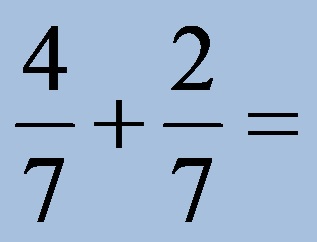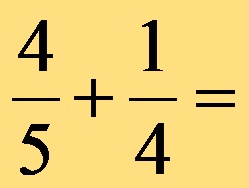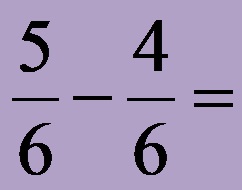In this post, we want to show you unique methods that will help you learn how to add and subtract fractions with different denominators. This is probably the first of many bitter problems that every person has gone through in the course of studying mathematics. Probably the first more serious problem that, if not removed properly, creates an unreliable knowledge base that further in the future creates even bigger problems. Therefore, here, we will try to contribute to solving this type of problem.
Adding And Subtracting Fractions With The Same Denominators
Before we start solving the bigger problem, we will first talk a little about the simpler situation that is easily solved. The question is how to add and subtract fractions with the same denominators.
Example 1: Calculate the sum of the fractions:

Obviously, in the example above, the denominator of both fractions is the same – the number 7. When we add fractions with the same denominators, the denominator remains the same (we don’t change it), while we get the numerator of the sum of the fractions as the sum of the individual numerators.
The solution looks like this:

Subtracting fractions with the same denominators is almost identical to adding them. Logically, the only difference concerning the addition of fractions with the same denominators is that we determine the numerator of the result as the difference between the individual numerators. Of course, even when subtracting fractions with the same denominators, we do not change the denominator, that is, it remains the same as the denominators of the individual fractions.
Add And Subtract Fractions With Different Denominators
The problem of adding and subtracting fractions becomes much more complicated when you try to add and subtract fractions with different denominators.
To determine the sum or difference of fractions of this type, we have to go through two different steps:
- We change the fractions into a suitable form. This means that we must first convert the two fractions (or more) into fractions that have the same denominators.
- Once we have completed the appropriate change, we add or subtract the fractions, with the new entry, using the method of adding and subtracting fractions with like denominators. This is the easy part of the solution, which you already saw in the first example of this post.
Example 2: Calculate the sum of the fractions:

It is seen that the denominator of the first fraction is the number 5. The denominator of the second fraction is the number 4. In the first step, we need to determine the least common denominator. It is an easy process (check how to determine the least common denominator for two numbers) for 4 and 5. After determining this characteristic number (for 4 and 5 is the number 20), we proceed as follows:

We expand both fractions to the denominator 20.
- Because the denominator of the first fraction – the number 5 is contained 4 times in the number 20, we expand the numerator of the first fraction with the number 4.
- Because the denominator of the second fraction – the number 4 is contained 5 times in the number 20, we expand the numerator of the second fraction with the number 5.
After the appropriate expansion, we get the following variant of the initial sum:

After the final calculation, the sum of the fractions with different denominators from example number two is:

Subtract Example
Example 3: Calculate the difference of fractions:

It is seen that the denominator of the first fraction is the number 6. The denominator of the second fraction is the number 3. In the first step, we need to determine the least common denominator for 6 and 3. After determining this number (the smallest denominator for 6 and 3 is the number 6), we proceed as follows:

We expand both fractions to the denominator 6.
- Because the denominator of the first fraction – the number 6 is contained once in itself, we expand the numerator of the first fraction with the number 1.
- Because the denominator of the second fraction – the number 3 is contained 2 times in the number 6, we expand the numerator of the second fraction with the number 2.
After the appropriate expansion, we get the following variant of the initial difference:

After the final calculation, the difference of the fractions with different denominators from example number three is:

The video available below contains many examples of adding and subtracting fractions with different denominators! See more examples!
We sincerely hope that this guide on how to add and subtract fractions with different denominators is effective. So we hope that helps you. We recommend that you also watch our video tutorials. They contain many examples of adding and subtracting fractions with different denominators.





